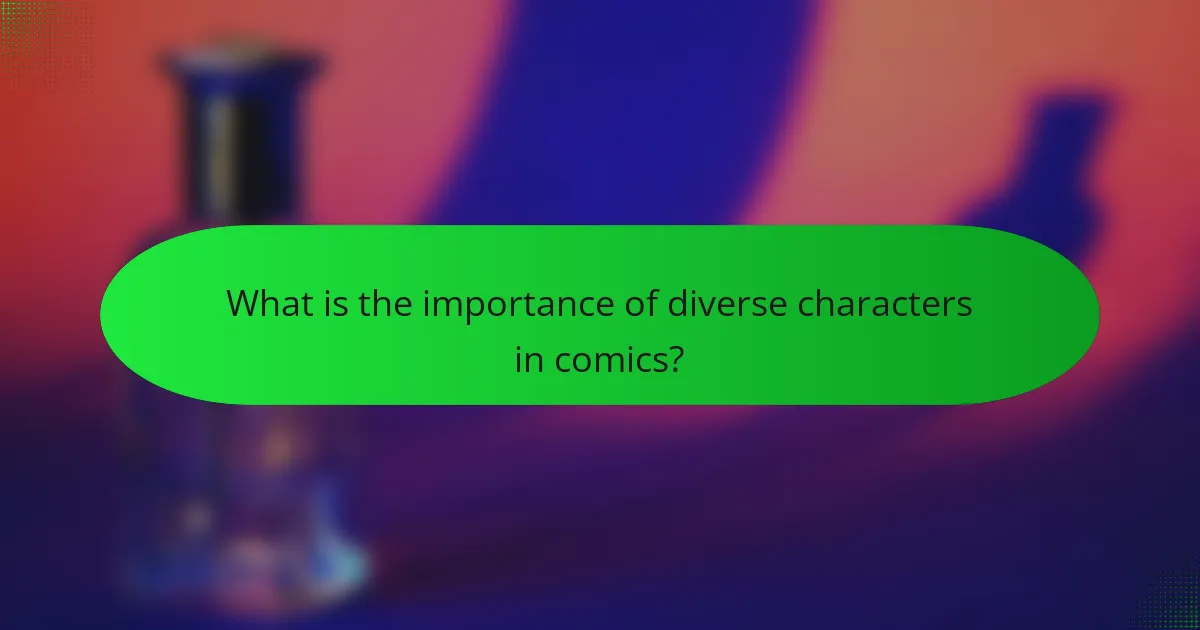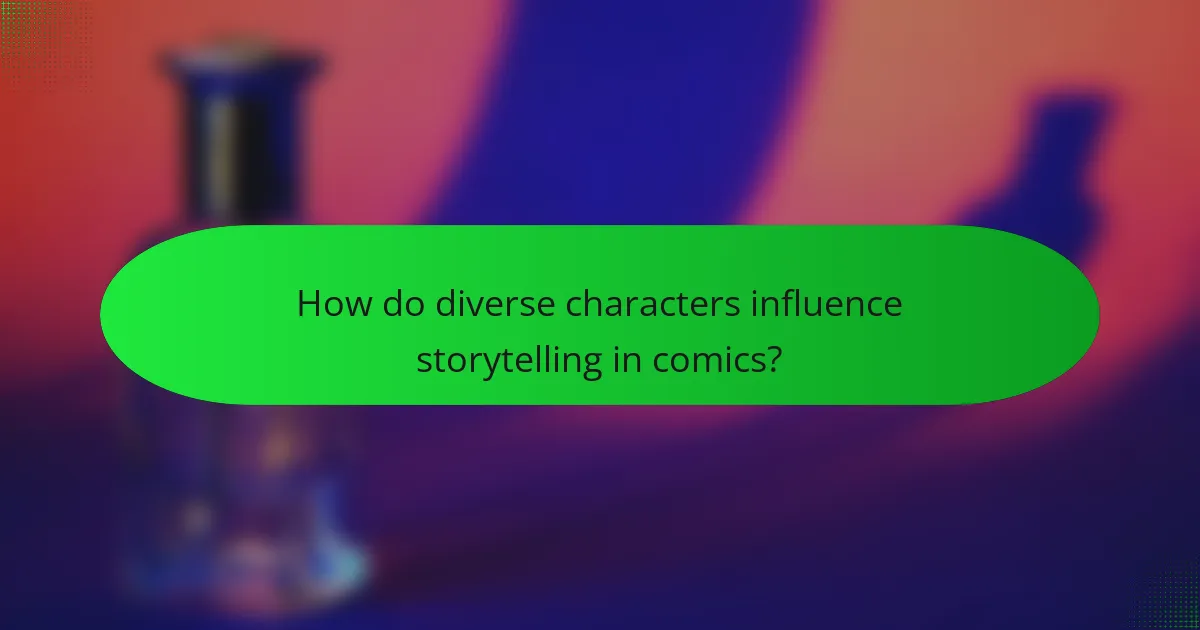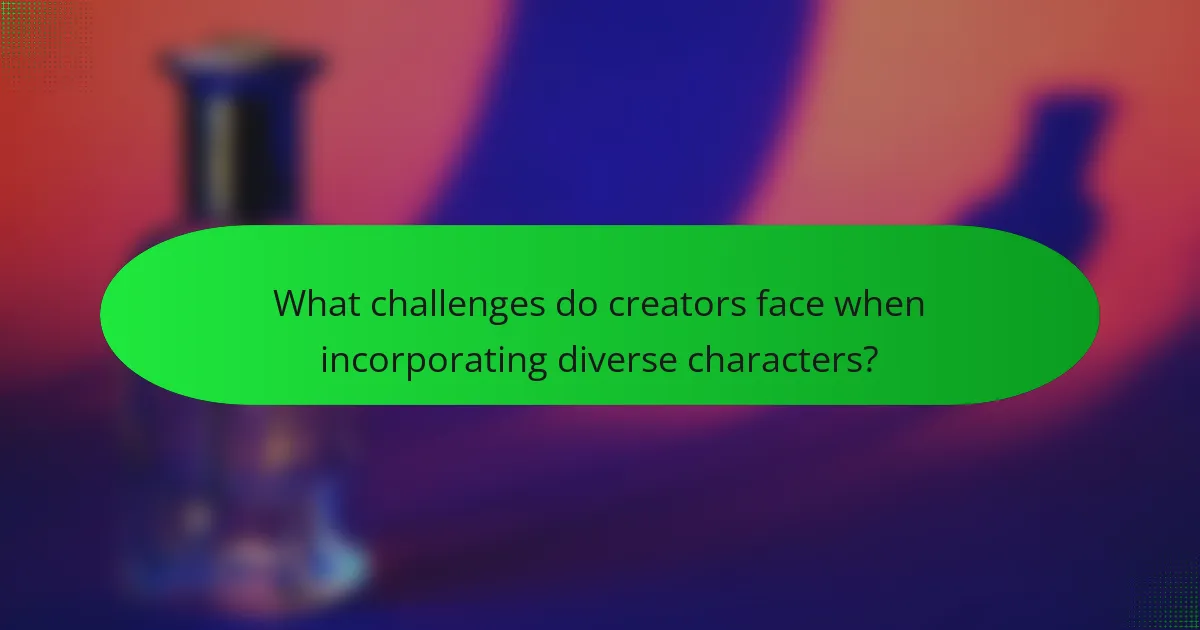Diverse characters in comics play a crucial role in enhancing representation and relatability for readers from various backgrounds. This article explores how such representation fosters emotional connections and validates the experiences of marginalized groups. It highlights the importance of diverse storytelling in increasing audience engagement and challenging stereotypes, citing research that demonstrates a significant boost in connection among underrepresented demographics. Additionally, the article addresses the challenges creators face, including stereotypes, authenticity, and audience reception, emphasizing the need for careful consideration in portraying diverse identities. Overall, the piece underscores the impact of diversity in enriching the comic medium and making narratives more reflective of society.

What is the importance of diverse characters in comics?
Diverse characters in comics are crucial for fostering representation and relatability. They reflect the varied experiences of readers from different backgrounds. This representation helps marginalized groups feel seen and validated. Studies show that diverse storytelling increases engagement and connection with audiences. For example, a 2018 report by the Geena Davis Institute found that diverse characters lead to wider audience appeal. Additionally, diverse characters can challenge stereotypes and promote understanding among different cultures. This enriches the narrative landscape of comics. Ultimately, diversity in comics enhances the medium’s relevance and impact in society.
How do diverse characters enhance audience connection?
Diverse characters enhance audience connection by reflecting the varied experiences of real-life individuals. They provide representation for underrepresented groups, fostering inclusivity. This representation allows audiences to see themselves in the stories, creating emotional resonance. Research shows that characters who mirror the audience’s backgrounds can lead to increased engagement. A study by the University of Southern California found that diverse representation in media positively affects viewer empathy. This connection encourages audiences to invest in the characters’ journeys. Ultimately, diverse characters enrich storytelling by broadening perspectives and deepening emotional ties.
What role do relatable characters play in reader engagement?
Relatable characters significantly enhance reader engagement. They foster emotional connections between the reader and the narrative. When readers see aspects of themselves in characters, they are more likely to invest in their journeys. This connection can lead to increased empathy and understanding of diverse experiences. Studies show that characters with relatable traits can boost reader retention and enjoyment. For instance, research by Mar and Oatley (2008) indicates that readers engage more deeply with stories featuring relatable protagonists. Ultimately, relatable characters serve as a bridge, facilitating a more immersive reading experience.
How does representation impact different demographics?
Representation significantly impacts different demographics by shaping identity, perception, and social dynamics. Diverse representation fosters a sense of belonging among underrepresented groups. It allows individuals to see themselves reflected in media, which can enhance self-esteem and cultural pride. Studies have shown that representation in media influences public attitudes and reduces stereotypes. For instance, a report from the Geena Davis Institute on Gender in Media highlights that female characters in film and television have increased visibility, leading to greater acceptance and empowerment of women in society. Furthermore, representation can drive social change by encouraging discussions about race, gender, and inclusion. This can lead to increased advocacy for equity and justice among various demographic groups. In summary, representation plays a crucial role in shaping the experiences and perceptions of different demographics in society.
Why is representation crucial in the comic industry?
Representation is crucial in the comic industry because it fosters inclusivity and relatability. Diverse characters reflect the variety of real-world experiences. This connection enhances audience engagement and broadens market appeal. Research shows that 45% of comic readers prefer stories featuring diverse characters. Representation also empowers underrepresented communities. It allows individuals to see themselves as heroes. This visibility can inspire creativity and self-acceptance. Ultimately, diverse representation enriches storytelling and promotes social awareness.
What historical context shapes the need for diverse characters?
The historical context shaping the need for diverse characters includes social movements and demographic changes. The Civil Rights Movement of the 1960s highlighted racial inequality and the demand for representation. This period saw the emergence of characters like Black Panther and Luke Cage in comics. Additionally, the feminist movement in the 1970s called for stronger female characters, leading to the creation of characters like Wonder Woman and Storm. The globalization of media in the late 20th century further emphasized the importance of diverse storytelling. As audiences became more multicultural, the demand for diverse characters increased. This context illustrates the evolving landscape of societal values and representation in comics.
How do diverse characters challenge stereotypes in storytelling?
Diverse characters challenge stereotypes in storytelling by presenting multifaceted identities. They break away from one-dimensional portrayals often seen in media. These characters reflect real-life diversity in culture, gender, and experience. By doing so, they foster empathy and understanding among audiences. Research shows that representation can positively influence viewers’ perceptions. For instance, a study by the Geena Davis Institute found that diverse media portrayals lead to greater acceptance of different groups. This indicates that diverse characters not only enrich narratives but also promote social change.

How do diverse characters influence storytelling in comics?
Diverse characters significantly enhance storytelling in comics by broadening perspectives and fostering inclusivity. They allow for varied narratives that resonate with a wider audience. This representation can lead to deeper emotional connections between characters and readers. For instance, characters from different backgrounds can reflect real-world issues, promoting empathy and understanding. Research shows that diverse storytelling can increase engagement by 30% among underrepresented demographics. Comics like “Ms. Marvel” and “Black Panther” exemplify how diverse characters can challenge stereotypes and inspire change. Ultimately, diverse characters enrich the comic medium by making stories more relatable and reflective of society.
What narrative techniques are used to portray diverse characters?
Narrative techniques used to portray diverse characters include character backstory, dialogue, and point of view. Character backstory provides context for a character’s identity and experiences. It helps readers understand their motivations and challenges. Dialogue reflects cultural nuances and distinct speech patterns, enhancing authenticity. Point of view allows readers to experience the world through a character’s perspective, fostering empathy. These techniques create depth and relatability. Studies show that diverse representation in narratives increases audience engagement and connection. For example, research by the University of Southern California highlights that inclusive storytelling leads to a broader audience appeal.
How do character backstories contribute to their diversity?
Character backstories significantly contribute to their diversity by providing unique contexts and experiences. These backstories reveal characters’ cultural, social, and personal histories. Different backgrounds lead to varied motivations and perspectives. For example, a character raised in a different country may have distinct values and beliefs. This diversity enriches storytelling and fosters relatability. Research shows that diverse characters lead to greater audience engagement. A study by the Geena Davis Institute on Gender in Media highlights that representation influences viewer perceptions positively. Thus, character backstories are essential for creating a diverse and relatable cast.
What impact does character development have on audience perception?
Character development significantly influences audience perception. Well-developed characters foster emotional connections with the audience. This connection enhances empathy and understanding of diverse experiences. Research by Green and Brock (2000) indicates that character depth increases narrative engagement. Audiences are more likely to relate to characters with complex backgrounds. This relatability can lead to a broader acceptance of diverse perspectives. In comics, nuanced character arcs contribute to a richer storytelling experience. Consequently, effective character development shapes how audiences interpret themes and messages within the narrative.
How can creators effectively include diverse characters?
Creators can effectively include diverse characters by conducting thorough research on various cultures and experiences. They should engage with communities to gain authentic perspectives. Incorporating feedback from diverse individuals during the creative process is crucial. This approach enhances representation and avoids stereotypes.
Utilizing diverse character backgrounds can enrich storytelling. For example, Marvel’s “Black Panther” showcases African culture and history, which resonated with many viewers. Studies show that diverse representation in media leads to increased audience engagement. A 2019 report from USC Annenberg found that films with diverse casts perform better at the box office.
By prioritizing authenticity and representation, creators can create relatable and impactful characters. This strategy not only broadens the audience but also fosters inclusivity in storytelling.
What research methods can be employed to ensure authentic representation?
Qualitative research methods can be employed to ensure authentic representation. These methods include interviews, focus groups, and ethnographic studies. Interviews allow for in-depth personal narratives from diverse individuals. Focus groups facilitate discussions among various communities to gather multiple perspectives. Ethnographic studies provide immersive insights into cultural contexts. Quantitative methods, such as surveys, can complement qualitative data by measuring representation perceptions. Additionally, content analysis can evaluate existing media for diversity representation. Research shows that diverse representation fosters greater audience connection and engagement. Studies indicate that audiences respond positively to characters reflecting their own backgrounds.
How can collaboration with diverse voices enhance character authenticity?
Collaboration with diverse voices enhances character authenticity by incorporating varied perspectives and experiences. This approach allows creators to depict characters that resonate more deeply with their audience. When individuals from different backgrounds contribute, they bring unique cultural insights. These insights help in creating well-rounded, relatable characters. Research shows that diverse teams produce more innovative results. According to a McKinsey report, companies with diverse workforces are 35% more likely to have financial returns above their industry medians. This statistic underscores the value of diverse input in creative processes. Therefore, collaboration fosters richer narratives and authentic representation in comics.

What challenges do creators face when incorporating diverse characters?
Creators face challenges such as stereotyping, authenticity, and audience reception when incorporating diverse characters. Stereotyping can lead to shallow portrayals that do not accurately reflect the complexities of diverse identities. Authenticity is crucial; creators must research and understand the cultures they represent to avoid misrepresentation. Audience reception can be unpredictable, as some viewers may resist change or feel alienated by new characters. Additionally, there may be pressure from publishers or stakeholders to conform to traditional narratives, limiting creative freedom. These challenges require careful consideration and sensitivity to ensure that diverse characters are portrayed respectfully and meaningfully.
What are common misconceptions about diverse representation in comics?
One common misconception about diverse representation in comics is that it only serves niche audiences. This belief overlooks the fact that diverse characters can resonate with a broader readership. Another misconception is that diverse representation dilutes traditional storytelling. In reality, it enriches narratives by introducing varied perspectives and experiences. Some people think that diverse characters are merely tokenistic additions. However, well-developed diverse characters can drive meaningful plots and themes. A further misconception is that diverse representation is a recent trend. Historical evidence shows that comics have included diverse characters since their inception, such as the early appearances of Black superheroes in the 1960s. These misconceptions hinder the appreciation of the depth and value that diverse representation brings to the comic book medium.
How do market trends affect the inclusion of diverse characters?
Market trends significantly influence the inclusion of diverse characters in comics. As audiences increasingly demand representation, publishers adapt to these preferences. A 2021 study by the Geena Davis Institute on Gender in Media found that 80% of consumers support diverse characters in media. This demand drives creators to incorporate varied backgrounds and identities into their narratives. Furthermore, market research indicates that diverse characters attract broader demographics. This expands the potential audience and increases sales. Consequently, the financial success of inclusive comics reinforces the trend. Thus, market trends create a feedback loop that promotes the inclusion of diverse characters.
What backlash or criticism do creators encounter?
Creators encounter backlash and criticism primarily for their representation choices. This includes accusations of tokenism when diverse characters are perceived as superficial additions. Some creators face backlash for altering established characters’ identities to promote diversity. Critics argue that this can alienate existing fan bases. Additionally, creators may receive negative feedback for not accurately portraying cultural experiences. This criticism often stems from a lack of understanding or research about the cultures they represent. Online platforms amplify dissent, leading to public disputes. Data shows that creators addressing diversity may experience both support and backlash simultaneously.
What best practices can creators follow to improve diversity in comics?
Creators can improve diversity in comics by incorporating a variety of cultural perspectives. This includes hiring writers and artists from diverse backgrounds. Diverse teams bring authentic voices and experiences to the storytelling process. Additionally, creators should research and understand the cultures they wish to represent. This helps avoid stereotypes and promotes accurate portrayals.
Moreover, creators can develop characters with rich backstories and unique traits that reflect diverse experiences. Engaging with communities can provide valuable insights and foster authenticity. Creators should also seek feedback from diverse audiences during the creation process. This ensures that the content resonates with a broader demographic.
Studies show that diverse representation in media leads to greater audience engagement and connection. According to a report by the Geena Davis Institute on Gender in Media, diverse characters can significantly enhance storytelling. This approach not only enriches the narrative but also promotes inclusivity in the comic industry.
How can feedback from diverse audiences shape character portrayal?
Feedback from diverse audiences can significantly shape character portrayal. It provides insights into cultural nuances and perspectives that creators may overlook. This feedback allows for more authentic representation of various identities. For example, characters reflecting diverse backgrounds can resonate more deeply with their respective communities. Studies show that diverse representation in media leads to increased audience engagement. A 2019 study by the Annenberg Inclusion Initiative found that inclusive storytelling improves viewer satisfaction. Therefore, incorporating audience feedback fosters richer, more relatable characters in comics.
What resources are available for creators to learn about diversity?
Creators can access various resources to learn about diversity. Books such as “Diversity in Comics” provide insights on representation. Online courses like those offered by Coursera focus on inclusive storytelling. Organizations such as the We Need Diverse Books initiative promote diverse narratives. Workshops and webinars are frequently hosted by industry professionals. Additionally, academic research on diversity in media is available through platforms like JSTOR. These resources help creators understand and implement diversity effectively in their work.
The main entity of this article is diverse characters in comics. The article emphasizes the significance of diverse characters for representation and relatability, highlighting their role in reflecting varied experiences and fostering inclusivity among readers. It discusses how diverse characters enhance audience connection, challenge stereotypes, and impact different demographics, while also addressing the historical context and challenges creators face in incorporating diversity. Additionally, it outlines best practices for creators to improve representation and the importance of audience feedback in shaping character portrayal.